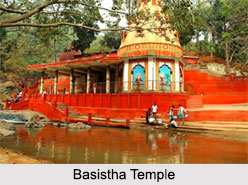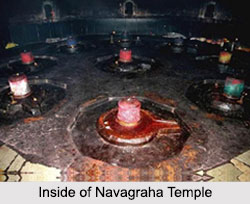 With numerous temples and monuments, the state of Assam is famous for its great historical and cultural past dating back to the medieval period. Guwahati, the largest city in this north eastern state has been aptly called the "city of temples". There are many Hindu temples in Guwahati and discussed elaborately below are few of them:
With numerous temples and monuments, the state of Assam is famous for its great historical and cultural past dating back to the medieval period. Guwahati, the largest city in this north eastern state has been aptly called the "city of temples". There are many Hindu temples in Guwahati and discussed elaborately below are few of them:
Kamakhya Temple: One of the oldest of the 51 Shakti Peethas, the Kamakhya Temple was built in the 10th century by the Koch king, Naranarayan. Being the centre for Tantric worship, this temple attracts thousands of tantric devotees in an annual festival known as the Ambubachi Mela. Another annual celebration is the Manasa Puja and the Durga Puja is celebrated during Navaratri in the autumn. This 5 day festival attracts several thousands of visitors from all over.
Basistha Temple: Dedicated to Lord Shiva, the Basistha Temple was constructed in 1764 by the Ahom king, Rajeswar Singha. Located in the south east corner of the city, it is said that the history surrounding the temple dates back to the Vedic period. The temple also houses an ashram on the 835 bighas land which was a gift from the Ahom king himself.
 As per legends, it is said that the ashram was founded by the great Indian sage Vasishtha, after whom the temple and ashram are named. The temple stands on the bank of the mountain streams originating from the hills of Meghalaya which becomes the rivers Basistha and Bahini or Bharalu flowing through the city.
As per legends, it is said that the ashram was founded by the great Indian sage Vasishtha, after whom the temple and ashram are named. The temple stands on the bank of the mountain streams originating from the hills of Meghalaya which becomes the rivers Basistha and Bahini or Bharalu flowing through the city.
Dirgheswari Temple: Situated on the northern banks of the Brahmaputra River, the Dirgheswari Temple is considered to be one of the Shakti Peethas that was built by the 18th century Ahom king, Sutanphaa. Other than being a Shakti Peetha, legend states that this is also the place where the Indian sage, Markandeya visited and started a huge penance for Goddess Durga. Pleased with his relentless devotion, the goddess blessed him and thus Dirgheswari became an important place of worship of Goddess Durga.
The sanctum sanctorum of the temple, where the idol of Goddess Durga is present is located underground, in a small cave. The Goddess Durga is revered by the people and the annual festivities of Durga Puja draws in a large crowd of tourists and devotees alike from all around. The natives residing in the place consider the Dirgheswari Temple to be the second holiest place after Kamakhya Temple.
Doul Govinda Temple: Primarily devoted to Lord Krishna, the Doul Govinda Temple is one of the important temples of Kamrup that is located on the foothills of the Chandra Bharati hill at Rajadaur. The first structure of the temple was erected more than 150 years ago but it was again renovated in 1966. The temple is famous for observing the popular Hindu festival of Holi, which is held for around 5 days and has about 5,000 pilgrims at the temple premises during this time.
 Lankeshwar Temple: An ancient Shiva temple, it is said that Lankeshwar is one of the many avatars of Lord Shiva. The devotees of Lord Shiva consider the Lankeshwar Temple as one of the most sacred Shiva temples in Guwahati. Devotees visit this temple all year round to seek divine blessings.
Lankeshwar Temple: An ancient Shiva temple, it is said that Lankeshwar is one of the many avatars of Lord Shiva. The devotees of Lord Shiva consider the Lankeshwar Temple as one of the most sacred Shiva temples in Guwahati. Devotees visit this temple all year round to seek divine blessings.
Rudreswar Temple: Dedicated to Lord Shiva, the Rudreswar Temple is a fine example of a mixed style of Ahom- Mughal architecture. It was built in 1749 CE by the Ahom king Pramatta Singha, in memory of his father Rudra Singha. Over the years, the temple has suffered greatly especially in the 1897 and 1950 Assam earthquakes. The temple`s upper structure had tremendous damages. In a bid to preserve the temple, the local people constructed the Manikut or the chamber roughly by woods and tins, to continue their religious functions.
Sukreswar Temple: Another important Shiva temple, the Sukreswar Temple was also constructed by Pramatta Singha in 1744 and was partly sponsored by Rajeswar Singha. The temple is located on the Sukreswar or Itakhuli hill on the southern bank of river Brahmaputra and has people visiting it to offer their prayers.
Ugro Tara Temple: An important Shakti shrine dedicated to Goddess Tara, the Ugro Tara Temple is located in the heart of the city of Guwahati. As per legends, it is said that the navel of Goddess Sati fell on the spot where the temple is currently constructed. Built in 1725 AD by the Ahom king, Shiva Singha, the sanctum sanctorum of the Ugro Tara Temple has no image or idol of the goddess, instead there is only a small pit filled with water that is considered to be the goddess.
Umananda Temple: Located at the Peacock Island in the middle of the Brahmaputra River, the Umananda Temple was built in 1694 AD by Gadadhar Singha. The presiding deity of the temple is Lord Shiva and it believed that worshipping here on the days of Amavasya and Shiva Chaturdashi brings in good luck and fortune.
Shree Shyam Mandir: One of the more recent temples in Guwahati, the Shree Shyam Mandir was built by Acharya Mahant Shri Pandit in April 2016. The temple is located in Chatribari, one of the main trade hubs in Guwahati. The presiding deity of Shree Shyam Mandir is Khatushyamji or Shyam baba.
Navagraha Temple: Representing the 9 celestial bodies of Hindu astronomy, the Navagraha Temple enshrines 9 Shiva Lingams. Each of these Lingams is covered with a coloured garment symbolic of each of the celestial bodies, with a Shiva Lingam in the centre symbolising the Sun. It was built in the late 18th century by Rajeswar Singha and has been renovated during the late 1923 to 1945.
These temples in Guwahati are not only famous for their religious aspect; they are also famous for being major places of tourist attractions in the city. Thus, it can be said that Guwahati as the "temple land of Assam" is absolutely correct and justifies the title with its several temples revealing its plethora of art and architecture.



















